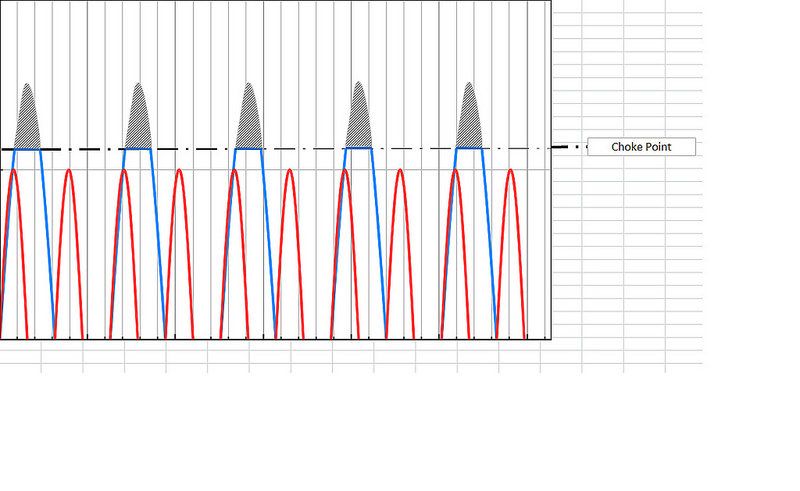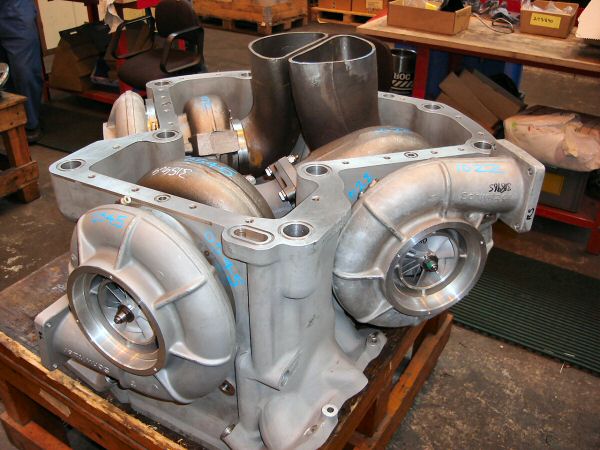Headcase98002
New member
Very informative.
Now how does a turbine wheel determine available shaft HP to drive the compressor?

The 73/80mm S300 turbine wheel on left is machine clipped from the manufacturer, it is clearly a different blade profile than the 68/76mm S300 turbine wheel on right.

I had always found that odd. Is it fair to assume, for lack of a better way of describing it, the "curved" blade design flows more on the turbine side?
dizuster said:So lets make an easy example (with fictitious easy to understand numbers) to show why peak pulsing pressures are not all the same. Engine one is twice as big as engine number two… but runs at half the RPM.
Engine #1 - 10 pulses of 1lb each in 1 second… 10pulses x 1lb / 1 second = 10lbs/sec.
Engine #2 - 20 pulses of 0.5lb each in 1 second… 20 pulses x 0.5lbs / 1 second = 10lbs/sec.
So both of them flow 10lbs/sec… but what’s actually happening inside the engine is much different.
If you looked at the pulses… they would look something like this (not exactly… but you get the idea).

Few big tall pulses for the big/low RPM engine… and many small short pulses for the small/high RPM engine.
But as was said before (and depicted in the flow charts previously in this post), there is a mass flow “choke point” to every turbine housing/wheel combination. What happens when that big pulse of the V8 “chokes” the turbine?... Then the flow will actually look like this…

Anything above the choke point (shown in grey hatching) will not actually flow as hoped… which means the pressure will continue to go up in the cylinder, but the flow will not increase.
What does this mean for the turbine? As outlined above, the flow through the turbine is maxed for a given pressure/flow once choked. The V8/Large Engine tries to force feed the turbo a huge volume of air on each exhaust stroke. This huge volume of air gets choked off, and does NOT flow through the turbine. This is what’s actually happening when you max out the hot side of a turbo.
This is also exactly why a small motor (with high RPM and many small exhaust pulses) can get more out of a given turbine then a big motor (with low RPM and few large exhaust pulses).
Both have the same overall flow rate, but they do it in different ways.
If you have a small motor, it will “pulse” many times (High RPM) and at lower air mass flow (small motor) for each exhaust stroke. These small pulses never go over the “choke point”, so they never lose any overall flow. The large V8 motor will do the opposite… it will pulse fewer times (low RPM) and at a higher mass flow (large motor) for each exhaust stroke. Each time the large engine pulse goes over the choke point, the piston is pushing harder (robbing horsepower), but getting no additional flow for the work it’s doing.
Since you can only shove in, what you can shove out… the small motor at high RPM can use more compressor for a given turbine/exhaust housing then the large V8 motor can.
I would think the large turbo in a traditional compound set would receive mostly linear flow. No?
So what you're saying is: Box stock turbos that are used for larger engines that we use for primaries do not have ideal turbine to compressor sizing.
I would think the large turbo in a traditional compound set would receive mostly linear flow. No?
If most high pressure turbos are also being wastegated you would assume that it would be on the or above the choke point the higher peaks as in the diagram above are being "muted" to some degree before reaching the primary?

